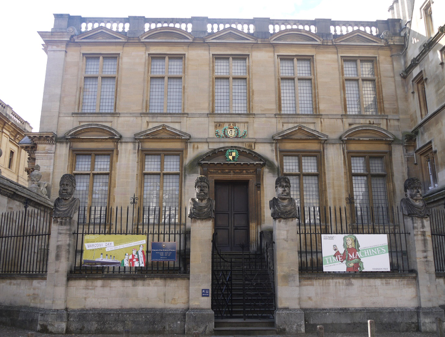When Albert Einstein lectured in Oxford in 1931, little did he know that 90 years later Oxford’s visitors would still be puzzling over his calculations. Einstein’s handwriting is clear though his equations are for most people – unfathomable. Nevertheless, the ‘Einstein Blackboard’ is today the most famous exhibit in Oxford’s Museum of the History of Science. See it here: Blackboard
Einstein himself grumbled about the Blackboard’s preservation. At the time he said it smacked of personality cult and in 1933 he objected that he had since discovered that everything he had said in the lecture was untrue (!). Needless to say, in the interests of tourism, the protests of the most famous scientist in history went unheeded.
In fact, as with all our University of Oxford museums, you can spend several days visiting virtually during lockdown. We thought we should just give you some history before you get started:
Oxford’s Museum of the History of Science was not the first occupant of the rather lovely limestone building on Broad Street that you can see in the photo. Opened in 1925, it grew from a much older Museum (discussed in a previous blog), the 17th century Ashmolean Museum. But right from the start, science featured. The original Ashmolean housed a lecture theatre, exhibition room and, in the basement, the University’s chemistry and anatomy laboratory.
Arguably the most interesting work took place in the basement, hidden from view, where the Tomlins Reader in Anatomy and his students would dissect people (!). By royal decree of Charles I in 1636, the body of anyone hanged within 21 miles of Oxford belonged to the University. Later medical students had to watch two dissections before qualifying. In today’s basement, you can still see some human bones and a skull (which someone should probably have buried).

You can also visit the largest collection of astrolabes in the world. What is an astrolabe? It is an instrument which helps in navigation and astronomy, in estimating the position of the sun and the stars. Many of our astrolabes come from the Islamic world and helped to ascertain prayer times and the direction of Mecca. Recently, the Museum of the History of Science collaborated with Syrian refugees in Oxford to put together an exhibition. Read their blog and see some astrolabes here: click here
Take the virtual tour Click here and don’t miss: The Penicillin exhibit in the basement. Penicillin was developed in Oxford in the 1940s by Professor Florey and his team. Here you can see not only the original bedpans and biscuit tins used to grow the mould (yes, they were short of research funding!), but even Professor Florey’s Nobel Prize medal.
For fans of Alice in Wonderland, see if you can find Lewis Carroll’s camera. Charles Dodgson (alias Lewis Carroll) was an accomplished photographer and even took some photos of the real Alice Liddell.
George III’s silver microscope is also stunning. But don’t take our word for it – browse the Museum Director’s top tips at Click here Stay well and enjoy!
When you come to Oxford, we recommend a trip to the museum either before or after a Walking Tours of Oxford tour. If you are particularly interested in Science and Medicine, we can even offer you a specialist Oxford Science and Medicine tour.
Private Tours
© Victoria Bentata 2020 for Walking Tours of Oxford
